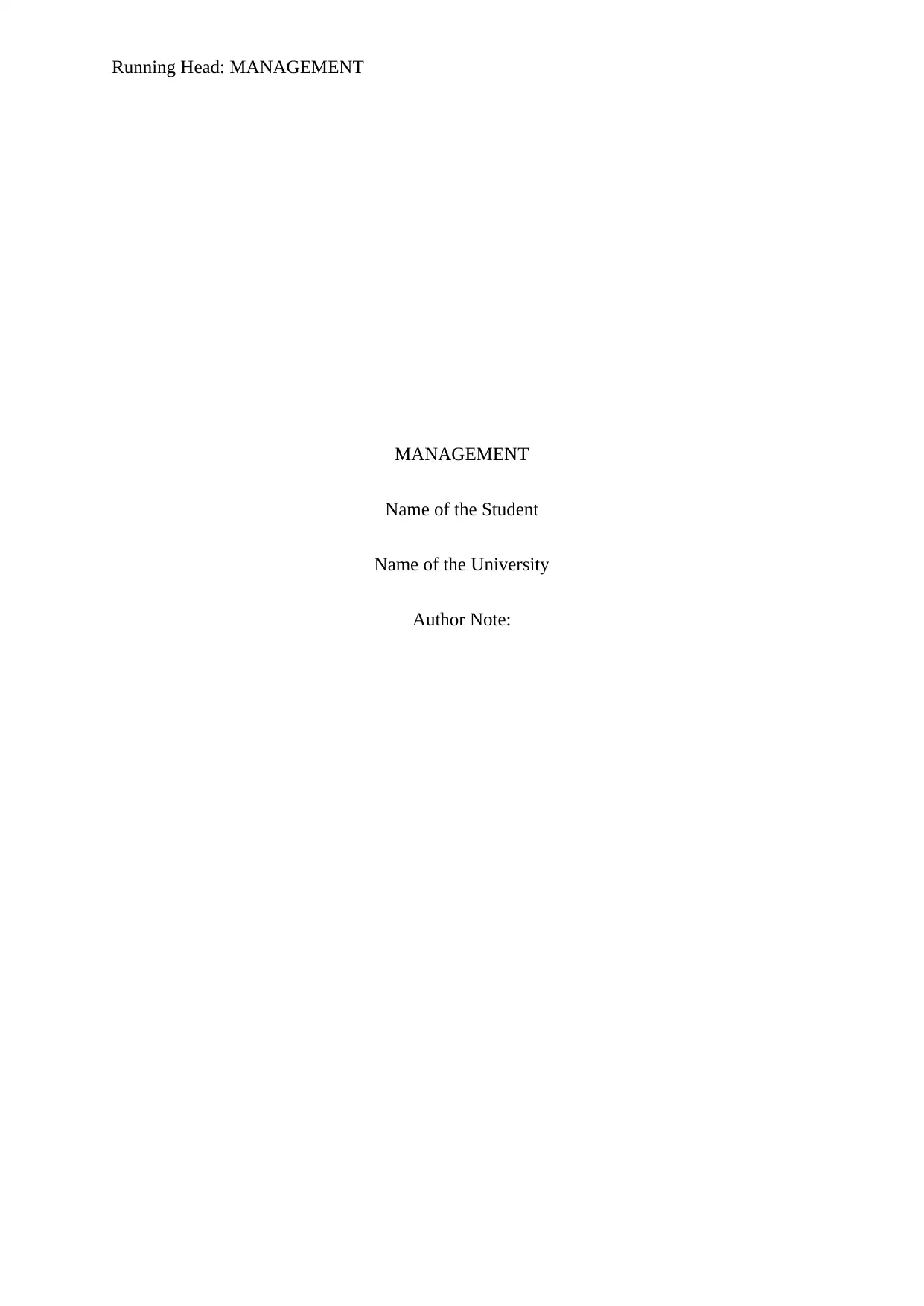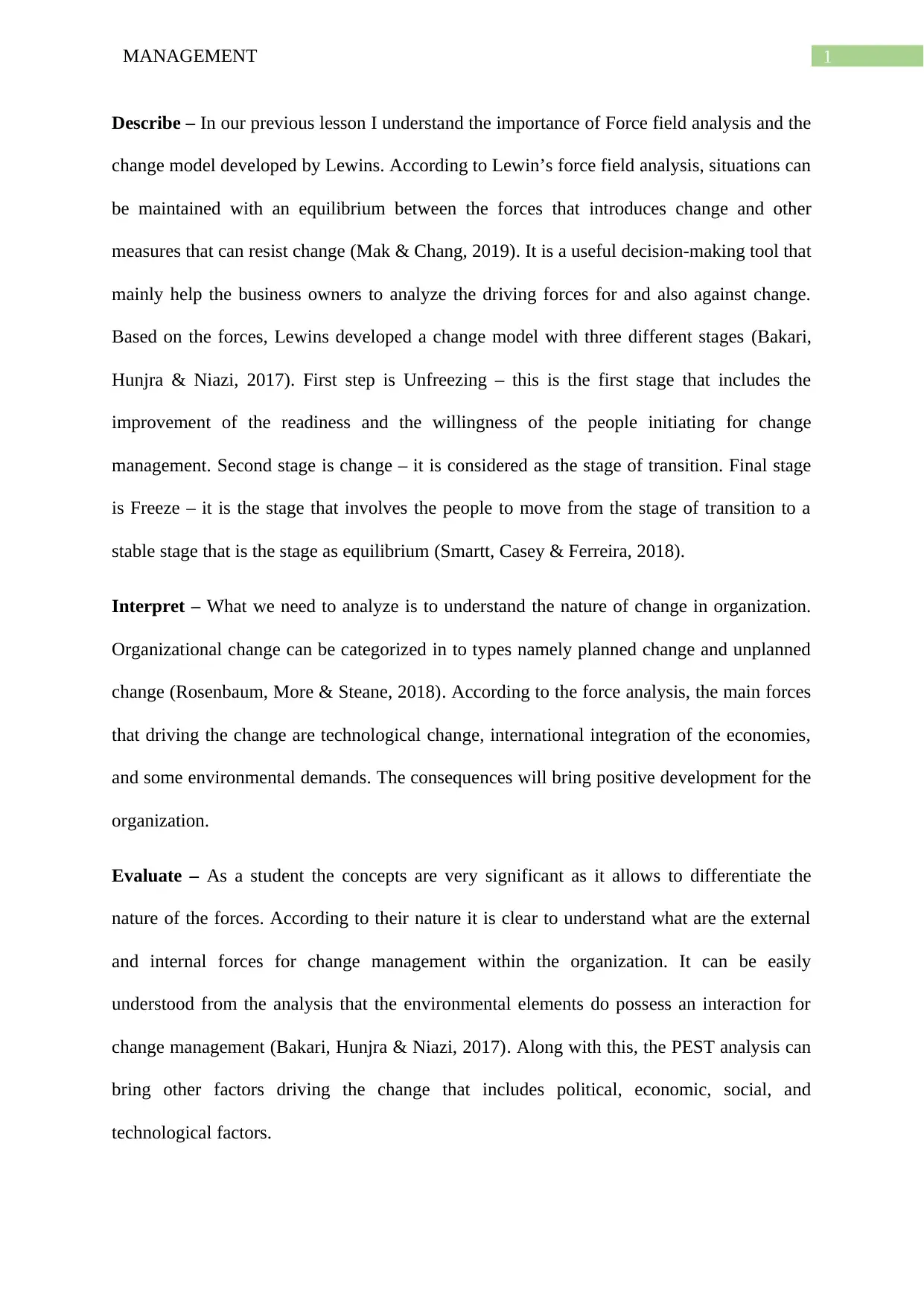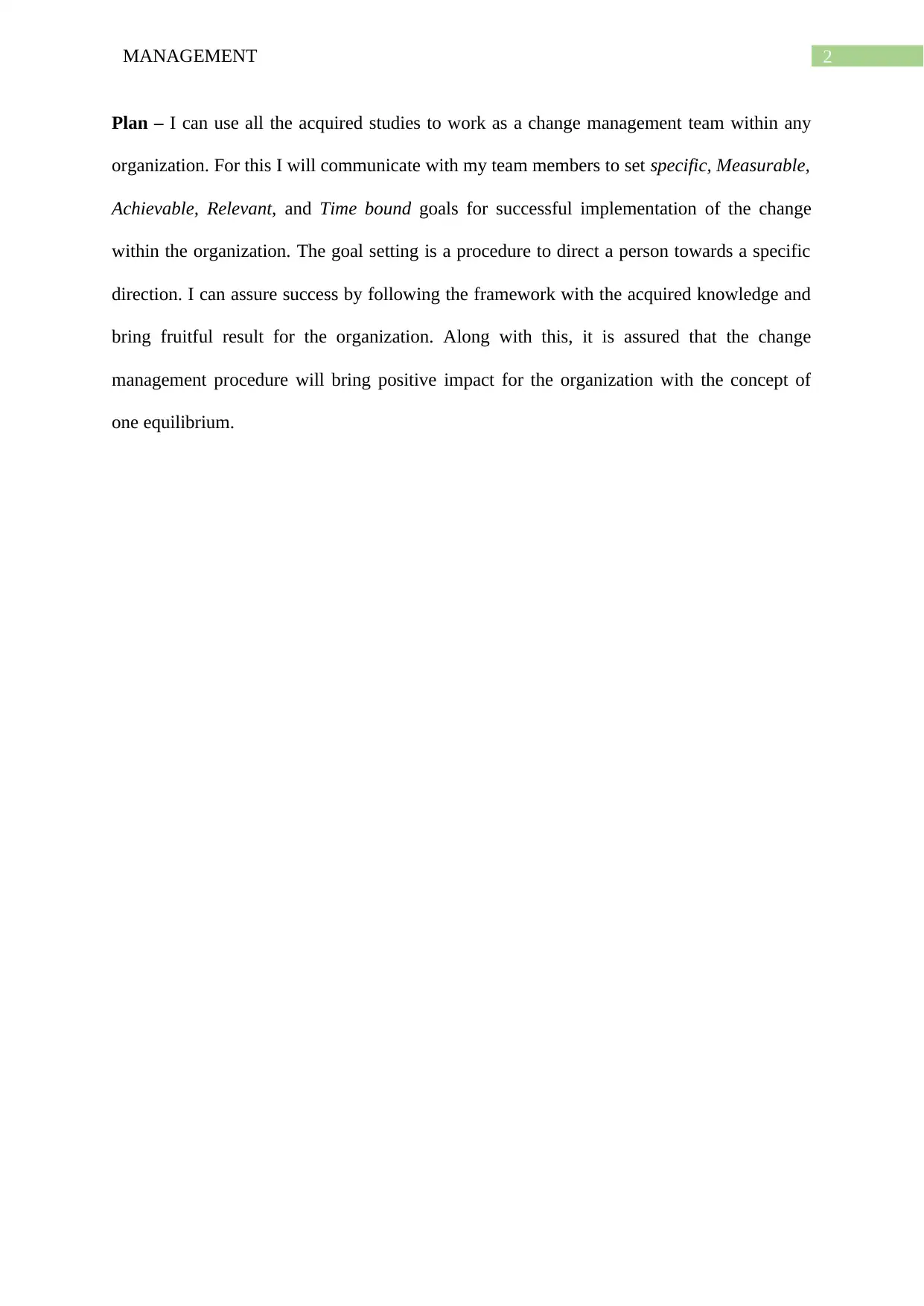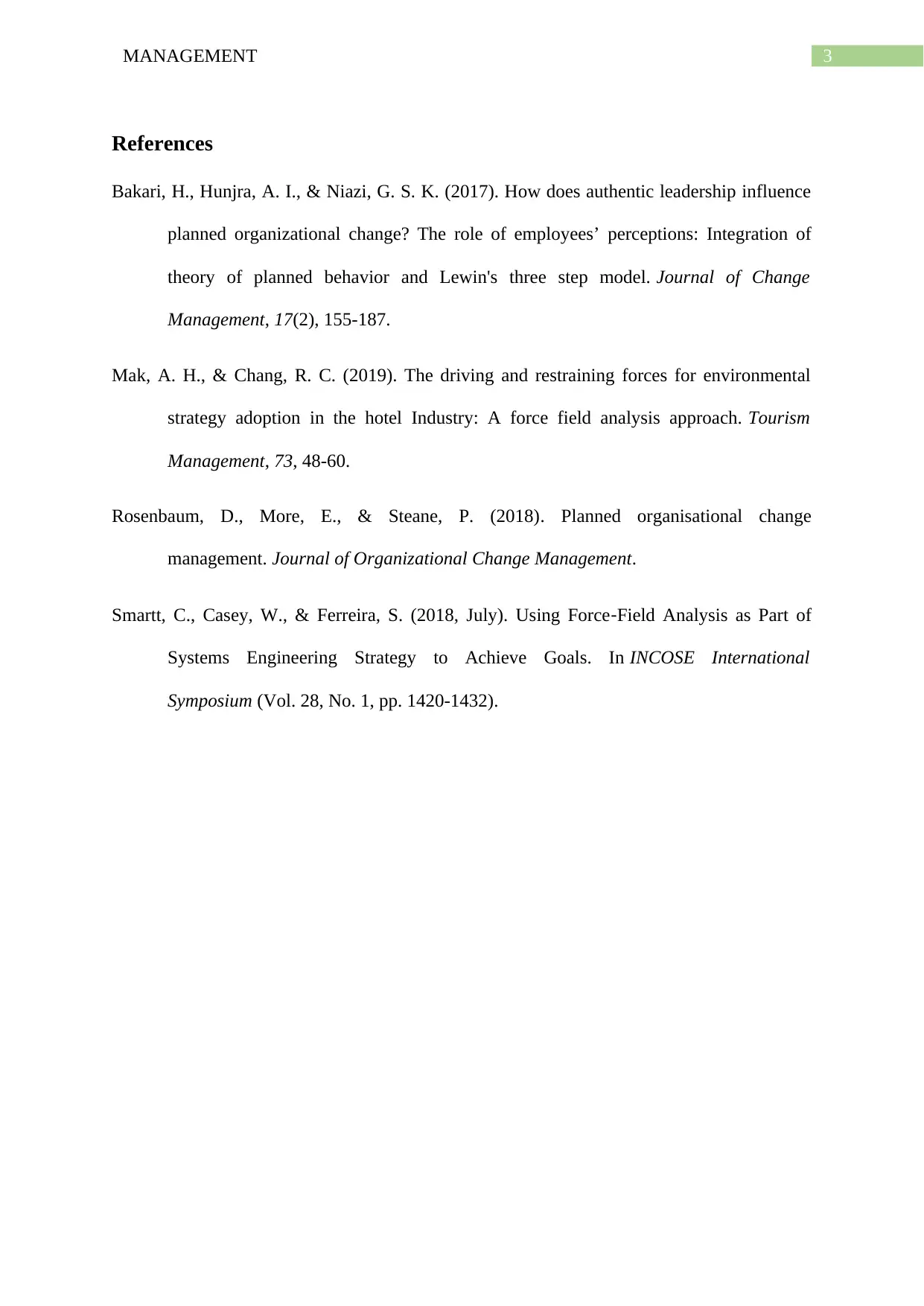ASSIGNMENT WHAT IS MANAGEMENT
VerifiedAdded on 2022/09/12
|4
|678
|22
Assignment
AI Summary
Contribute Materials
Your contribution can guide someone’s learning journey. Share your
documents today.

Running Head: MANAGEMENT
MANAGEMENT
Name of the Student
Name of the University
Author Note:
MANAGEMENT
Name of the Student
Name of the University
Author Note:
Secure Best Marks with AI Grader
Need help grading? Try our AI Grader for instant feedback on your assignments.

1MANAGEMENT
Describe – In our previous lesson I understand the importance of Force field analysis and the
change model developed by Lewins. According to Lewin’s force field analysis, situations can
be maintained with an equilibrium between the forces that introduces change and other
measures that can resist change (Mak & Chang, 2019). It is a useful decision-making tool that
mainly help the business owners to analyze the driving forces for and also against change.
Based on the forces, Lewins developed a change model with three different stages (Bakari,
Hunjra & Niazi, 2017). First step is Unfreezing – this is the first stage that includes the
improvement of the readiness and the willingness of the people initiating for change
management. Second stage is change – it is considered as the stage of transition. Final stage
is Freeze – it is the stage that involves the people to move from the stage of transition to a
stable stage that is the stage as equilibrium (Smartt, Casey & Ferreira, 2018).
Interpret – What we need to analyze is to understand the nature of change in organization.
Organizational change can be categorized in to types namely planned change and unplanned
change (Rosenbaum, More & Steane, 2018). According to the force analysis, the main forces
that driving the change are technological change, international integration of the economies,
and some environmental demands. The consequences will bring positive development for the
organization.
Evaluate – As a student the concepts are very significant as it allows to differentiate the
nature of the forces. According to their nature it is clear to understand what are the external
and internal forces for change management within the organization. It can be easily
understood from the analysis that the environmental elements do possess an interaction for
change management (Bakari, Hunjra & Niazi, 2017). Along with this, the PEST analysis can
bring other factors driving the change that includes political, economic, social, and
technological factors.
Describe – In our previous lesson I understand the importance of Force field analysis and the
change model developed by Lewins. According to Lewin’s force field analysis, situations can
be maintained with an equilibrium between the forces that introduces change and other
measures that can resist change (Mak & Chang, 2019). It is a useful decision-making tool that
mainly help the business owners to analyze the driving forces for and also against change.
Based on the forces, Lewins developed a change model with three different stages (Bakari,
Hunjra & Niazi, 2017). First step is Unfreezing – this is the first stage that includes the
improvement of the readiness and the willingness of the people initiating for change
management. Second stage is change – it is considered as the stage of transition. Final stage
is Freeze – it is the stage that involves the people to move from the stage of transition to a
stable stage that is the stage as equilibrium (Smartt, Casey & Ferreira, 2018).
Interpret – What we need to analyze is to understand the nature of change in organization.
Organizational change can be categorized in to types namely planned change and unplanned
change (Rosenbaum, More & Steane, 2018). According to the force analysis, the main forces
that driving the change are technological change, international integration of the economies,
and some environmental demands. The consequences will bring positive development for the
organization.
Evaluate – As a student the concepts are very significant as it allows to differentiate the
nature of the forces. According to their nature it is clear to understand what are the external
and internal forces for change management within the organization. It can be easily
understood from the analysis that the environmental elements do possess an interaction for
change management (Bakari, Hunjra & Niazi, 2017). Along with this, the PEST analysis can
bring other factors driving the change that includes political, economic, social, and
technological factors.

2MANAGEMENT
Plan – I can use all the acquired studies to work as a change management team within any
organization. For this I will communicate with my team members to set specific, Measurable,
Achievable, Relevant, and Time bound goals for successful implementation of the change
within the organization. The goal setting is a procedure to direct a person towards a specific
direction. I can assure success by following the framework with the acquired knowledge and
bring fruitful result for the organization. Along with this, it is assured that the change
management procedure will bring positive impact for the organization with the concept of
one equilibrium.
Plan – I can use all the acquired studies to work as a change management team within any
organization. For this I will communicate with my team members to set specific, Measurable,
Achievable, Relevant, and Time bound goals for successful implementation of the change
within the organization. The goal setting is a procedure to direct a person towards a specific
direction. I can assure success by following the framework with the acquired knowledge and
bring fruitful result for the organization. Along with this, it is assured that the change
management procedure will bring positive impact for the organization with the concept of
one equilibrium.

3MANAGEMENT
References
Bakari, H., Hunjra, A. I., & Niazi, G. S. K. (2017). How does authentic leadership influence
planned organizational change? The role of employees’ perceptions: Integration of
theory of planned behavior and Lewin's three step model. Journal of Change
Management, 17(2), 155-187.
Mak, A. H., & Chang, R. C. (2019). The driving and restraining forces for environmental
strategy adoption in the hotel Industry: A force field analysis approach. Tourism
Management, 73, 48-60.
Rosenbaum, D., More, E., & Steane, P. (2018). Planned organisational change
management. Journal of Organizational Change Management.
Smartt, C., Casey, W., & Ferreira, S. (2018, July). Using Force‐Field Analysis as Part of
Systems Engineering Strategy to Achieve Goals. In INCOSE International
Symposium (Vol. 28, No. 1, pp. 1420-1432).
References
Bakari, H., Hunjra, A. I., & Niazi, G. S. K. (2017). How does authentic leadership influence
planned organizational change? The role of employees’ perceptions: Integration of
theory of planned behavior and Lewin's three step model. Journal of Change
Management, 17(2), 155-187.
Mak, A. H., & Chang, R. C. (2019). The driving and restraining forces for environmental
strategy adoption in the hotel Industry: A force field analysis approach. Tourism
Management, 73, 48-60.
Rosenbaum, D., More, E., & Steane, P. (2018). Planned organisational change
management. Journal of Organizational Change Management.
Smartt, C., Casey, W., & Ferreira, S. (2018, July). Using Force‐Field Analysis as Part of
Systems Engineering Strategy to Achieve Goals. In INCOSE International
Symposium (Vol. 28, No. 1, pp. 1420-1432).
1 out of 4
Related Documents
Your All-in-One AI-Powered Toolkit for Academic Success.
+13062052269
info@desklib.com
Available 24*7 on WhatsApp / Email
![[object Object]](/_next/static/media/star-bottom.7253800d.svg)
Unlock your academic potential
© 2024 | Zucol Services PVT LTD | All rights reserved.





